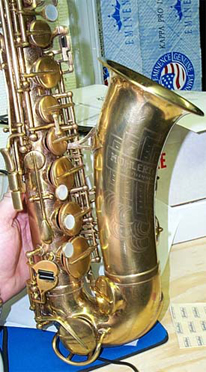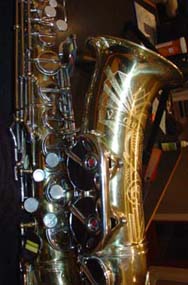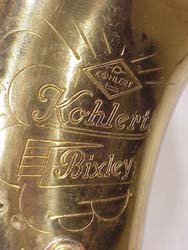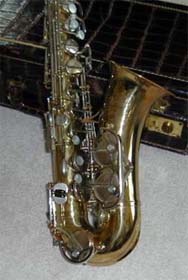Kohlert Model Breakdown
Kohlert Models; 1949 to 1977
| SOTW's Kohlert Forum | Website Home |
A preliminary note:
Originally, the designations “Regent”, “Popular” and “de Luxe” seem to have referred to finish, tonehole and/or keywork choices, and were not a “real” model desgination. However, by the 1950’s, this not only referred to finish choice, but also, with the addition of the Bixley models, student through professional quality.
I base this on a couple of observations:
* In my “Pre-WWII” set of horns, I have pictures of several nickel plated altos that lack G# trill keys and forked Eb keys labeled “Popular”, but the silver plated, unlabeled altos have both and have more elaborate engraving (no help from the contrabass or sopranino)
* I’ve got several of the beautiful “VKS” horns in my databases, but they’re all engraved a bit differently:
- I have pictures of a lacquered alto with no engraving (other than the standard), but it has additional pearl inlay
- I have pictures of a silver plated horn labeled “Regent”, but it lacks additional pearl inlay
- I have pictures of a silver plated horn labeled “Popular”, but it lacks a G# trill and fork Eb fingering.
(Do note that the G# cluster also is somewhat different on each)
* In the 1950’s, I have pictures of the Regent, again. The tenor I have pics of looks exactly like a 57, but it’s in nickel plate and the serial number sorta-kinda indicates it’s made in 1956 – when Kohlert’s pro model was really a Keilwerth stencil by way of Amati.
The “de Luxe” made its debut or re-introduction in the 1960’s, after Kohlert quality had taken an immense nosedive. However, this model had rolled tone holes – and that seems the only difference between this and other Kohert models of the same era.
One other note: only the names below not in quotes are the Kohlert bona fide model names. The others I've "invented" to make the below list easier to create.
WINNENDEN (1949 to 1954): This is unquestionably Kohlert’s first new horn to be produced after WWII. It, to me, looks like a Martin Handcraft Committee II crossed with a Buescher True Tone crossed with a Malerne. The tone holes are again on the left side of the horn.
“KEILWERTH” (1956): In 1956, Kohlert stenciled a horn, rather than producing their own. It’s an Amati Toneking stencil with a Keilwerth serial number. Confused yet?
At the end of WWII, Amati “nationalized” the Kohlert and Keilwerth companies and produced horns using, mainly, the Keilwerth tooling (very few used the Kohlert tooling -- see above). They kept the same Keilwerth model name, “Best in the World” stamp and serial number chart, even.
These horns are not the equivalent of “real” Keilwerth horns: the keywork is a bit lacking.
“1950's MODELS ” (1955 to 1959, excepting 1956): Again, Kohlert labeled a group of horns according to specific years produced: 55, 57, 58 and 59. These are the last “good” Kohlerts ever produced, according to most popular opinion, with the 57 being the unarguable best.
The 55 is essentially a slightly redesigned Winnenden, but the 57 is a completely new design with right hand bell keys and somewhat reworked keywork. According to some, particularly www.cybersax.com, it’s on par with the Mark VI in terms of sound quality.
In 1956, Kohlert’s pro model was actually an Amati-assembled Keilwerth (see above), but they seem to have reintroduced the Regent around this time. IMHO, this horn looks like a 57 with different plating. If you look at a 1958 Regent – and factor in comments from some owners – it appears that the Regent became an “intermediate” model by the time the 57 was actually introduced.
BIXLEY (1957 to 1966): 1957 was a good year for Kohlert. They had just entered into their agreement with Western distributors in 1955 and needed to produce an intermediate/student model to meet the demand.
The Bixley is definitely a mass-produced, fairly low quality student horn that was sold primarily as a Boosey & Hawkes stencil called either “The Edgware” (note the spelling -- not "Fogware") or “The Oxford” (if you happened to get one in Canada ). It’s possible that these horns were also sold by Sears in the US as either the “Silvertone” or “Concertone” model (no pictures yet).KOHLERT (1960 to 1977): The last series of Kohlert horns is supposed to have been called “Popular, Regent, Star and Excelsior” (see the company history). I’ve yet to find “Star” or “Excelsior” engraved on any Kohlert horn (possibly a bad translation from Czech to English to German to English), though.
There are at least two variants that I’ve seen:
* de Luxe models: these are the rolled-tone-hole versions.
* non-engraved: these are models engraved only with the Kohlert logo. They have straight tone holes.
Regent and Bixley variants were still occasionally available. After 1966, it’s probable that these two models went away completely.
The highest serial number I have seen is 92656. Because I like big round numbers, I hope that maybe Kohlert got to 100000. The only thing that's documented, though, is that saxophone production did end in 1977.







